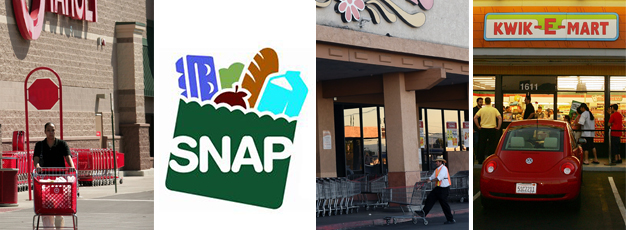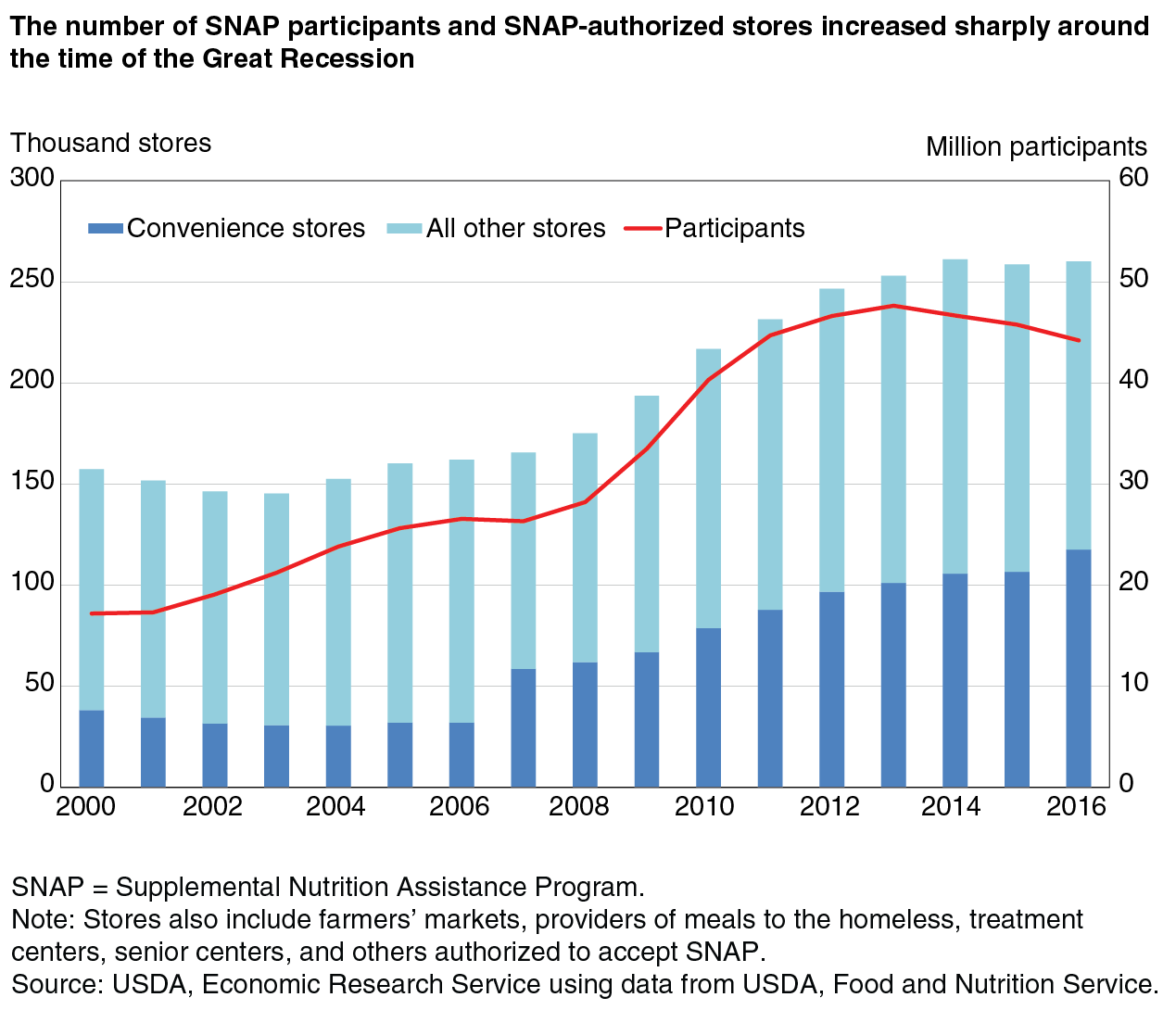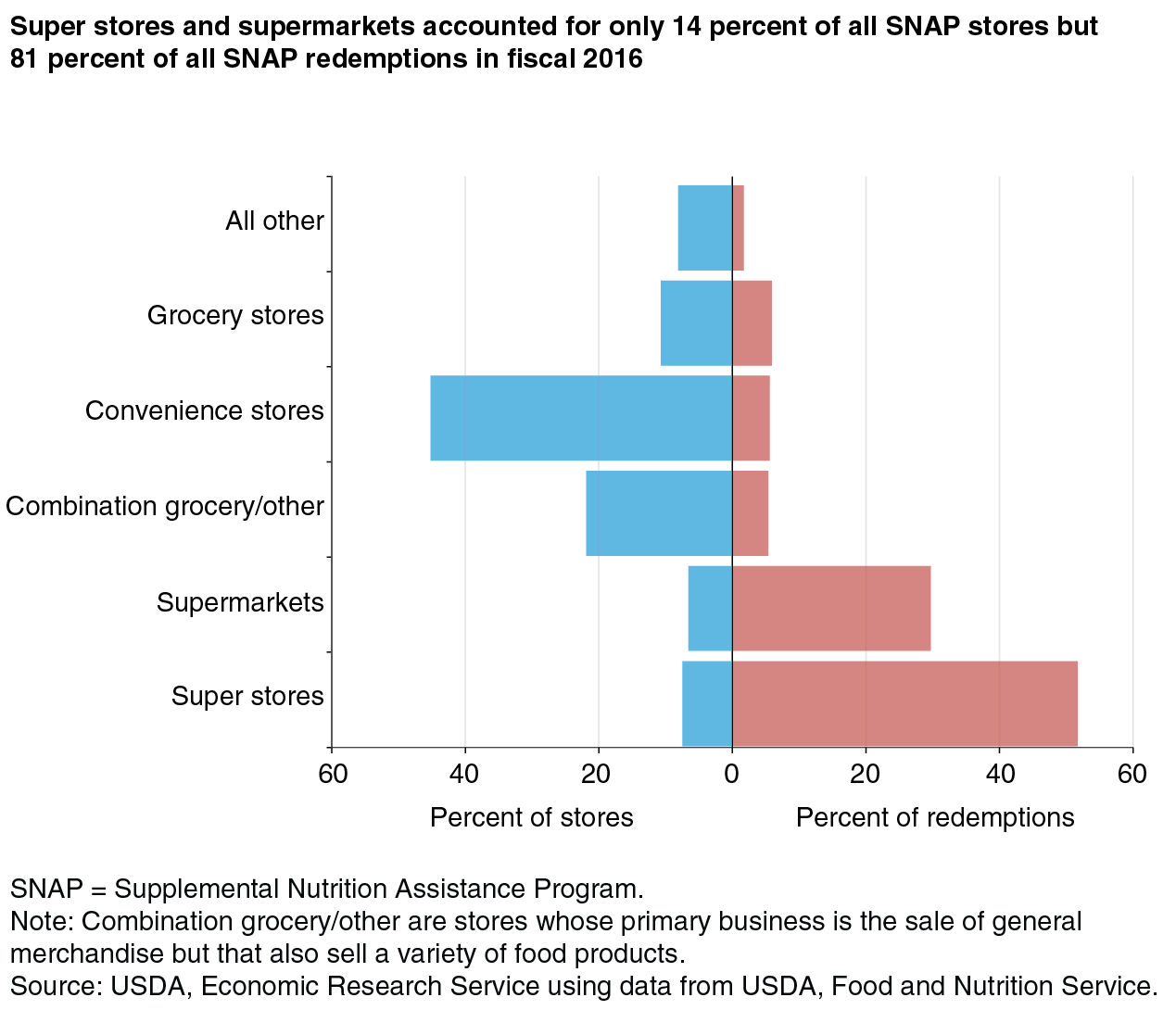
Eligibility Requirements for SNAP Retailers: Balancing Access, Nutrition, and Integrity
- by Victor Oliveira, Mark Prell and Laura Tiehen
- 1/25/2018
Highlights
- SNAP participants can redeem their food benefits nationwide in over a quarter of a million authorized retail food stores.
- In recent years, policymakers have revised the SNAP store requirements pertaining to the varieties, types, and amounts of foods offered.
- These revisions have implications for small food retailers, which in turn may affect the nutritional content of foods offered, participants’ access to food, and program integrity.
The Supplemental Nutrition Assistance Program (SNAP)—formerly the Food Stamp Program—is the cornerstone of USDA’s food assistance programs. On average, 44.2 million people, or about 1 in 7 Americans, participated in the program each month in fiscal 2016. Participants received an average $126 per person (or about $255 per household) in benefits each month to purchase food in authorized retail food stores. By increasing low-income households’ food purchasing power, SNAP improves participants’ ability to obtain an adequate and healthful diet.
To become an authorized SNAP food store, retailers are required to meet various criteria. Policymakers face tradeoffs when establishing eligibility standards for these retailers. Stricter standards regarding the variety and types of foods offered can enhance the nutritional content of foods in qualifying stores and improve program integrity. On the other hand, stricter standards could potentially reduce the number of qualifying stores thereby diminishing participant access. Access to food stores is an important issue for those SNAP participants who have limited transportation options.
In December 2016, USDA’s Food and Nutrition Service (FNS)—the agency that administers SNAP—issued regulations that increased the number of varieties of food items that stores are required to stock on their shelves for a store to be authorized to accept SNAP benefits. The 2016 regulations also clarified the definition of a retail food store to exclude establishments where much of their sales are cold or uncooked foods that are heated or cooked on site. These tightened retailer eligibility criteria could decrease the number of SNAP-authorized stores and alter the distribution of store types. Larger retail food stores that already stock a large number and variety of staple foods—such as meat, bread, and vegetables—should be unaffected by the new requirements. However, smaller stores may have to expand their staple offerings to continue redeeming SNAP benefits.
SNAP Uses the Retail Food Distribution System
A key feature of the Food Stamp Act of 1964, which permanently authorized the program, mandated that it be operated through “normal channels of trade,” i.e., the commercial retail food distribution system. This requirement has proven to be beneficial to retailers, participants, and the program itself.
SNAP’s use of retail food stores helps participating food retailers build their businesses by gaining customers and increasing revenues. In fiscal 2016, over $66 billion in SNAP benefits were redeemed. Nationally, SNAP benefits account for about 10 percent of all spending for food-at-home. SNAP retailers receive additional revenue when SNAP customers purchase other food or nonfood items using their own cash when redeeming their SNAP benefits.
The use of retail food stores means that most SNAP households can redeem their SNAP benefits at their usual food store(s) rather than traveling to a government-operated store (as occurs in other countries). The U.S. retail food system also provides recipients with access to a wide variety of nutritious foods. SNAP benefits can be redeemed for any food or food product meant for home consumption except alcoholic beverages, tobacco, and hot foods ready for immediate consumption. By giving SNAP households a wide range of foods to purchase, SNAP provides the flexibility for households to purchase foods based on their individual circumstances, dietary needs, and food preferences.
For SNAP, using normal retail channels is considered to be less expensive and more efficient than developing a separate distribution system. Because SNAP stores generally operate in a competitive retail food environment, they have a profit incentive to keep costs and prices low. SNAP retailers must charge SNAP customers the same prices as non-SNAP customers.
The SNAP Food Store Landscape
Retailers participate in SNAP on a voluntary basis. As of September 2016, over a quarter million (260,115) food retailers were authorized to redeem SNAP benefits—a 79-percent increase from 2003. The growth in the number of SNAP-authorized stores was especially large over 2008-12. This increase coincided with a sharp rise in the number of SNAP participants that was largely due to the economic downturn that accompanied the Great Recession and increased demand for food assistance. Much of the growth in the number of SNAP stores was the result of more convenience stores (small stores that sell a limited number of food and other products) applying for and receiving authorization to accept SNAP benefits. The number of SNAP authorized convenience stores more than tripled from 2003 to 2016.
In fiscal 2016, convenience stores accounted for 45 percent of all SNAP stores, but less than 6 percent of all redemptions. Conversely, super stores (large stores containing a wide variety of goods including both food and nonfood items) and supermarkets accounted for 81 percent of national SNAP redemptions, but only 14 percent of the number of SNAP stores. Thus, a relatively small number of stores redeem the bulk of SNAP benefits. Super stores and supermarkets generally have lower prices than smaller stores. Because SNAP benefits are for a fixed dollar amount, participants have an incentive to stretch their benefits by seeking out the best values when choosing where to spend their benefits.
Different store types have implications for store access and for nutritious food options. Larger food stores such as supermarkets and super stores offer consumers a wider variety of nutritious foods than smaller stores. However, because there are fewer of them, larger stores are less accessible for some SNAP participants, in particular, those who do not own a car. However, factors such as the availability of a car to borrow or combining shopping trips with someone else, can mitigate this barrier. An earlier ERS study found that 34 percent of SNAP households use someone else’s car or ride with someone or they rely on public transportation, walk, or bike to do their grocery shopping compared with 5 percent of non-SNAP households (see box “Travel Mode to Food Shopping by SNAP Status”).
On the other hand, convenience stores are relatively small and carry fewer healthy foods and, generally, at higher prices. However, because of their large numbers, they provide increased access to more participants, especially for people in rural or inner city areas.
Revising Retailer Eligibility Standards Increases the Number of Staple Food Offerings …
Throughout the history of SNAP, policymakers have adjusted the eligibility standards for stores wanting to accept SNAP benefits. For example, the Food Stamp Act of 1977 limited participating stores to those in which at least half of their food sales were staple foods (i.e., basic foods that make up a significant portion of a person’s diet and are usually prepared at home and eaten as a meal). Examples of items not deemed to be staples—referred to as “accessory food”—included coffee, tea, cocoa, carbonated and uncarbonated drinks, candy, ice cream, condiments, and spices. Thus, specialized stores selling only accessory foods (such as donut and ice cream shops) were prohibited from participating in the program.
To strengthen the nutritional focus of the program, legislation in 1994 revised retailer eligibility requirements. Rather than requiring a store to have more than 50 percent of its total food sales in staple foods, the new requirement, known as criterion B, was that more than 50 percent of its total sales be in staple foods. This revision blocked authorization for some marginal food stores, which primarily sell nonfood items but that had sold the required percentage of staple foods compared to total food, such as liquor stores and gas stations.
Congress was concerned that a large number of food stores would not be able to meet criterion B—especially in rural areas and inner cities. Thus, the 1994 legislation provided a second pathway, known as criterion A, to SNAP-authorization based on the variety and perishability of food sold. Specifically, stores could be authorized to accept SNAP benefits if they offered for sale, on a continuous basis, at least three varieties of qualifying foods in each of the four categories of staple foods: meat, poultry or fish; bread or cereal; vegetables or fruits; and dairy products. Stores had to offer perishable foods in at least two of the four categories. As a result, stores that do not sell a high proportion of staple foods—such as convenience stores—were able to continue participation in the program by offering at least 12 staple food items.
Criterion A is considered to be the primary pathway used to authorize SNAP stores. Criterion B is the backup authorization criteria, usually applied to specialty stores. In 2014, Congress passed legislation to increase the variety of nutritious foods that must be provided by stores that are authorized under criterion A.
In December 2016, FNS issued new regulations that codified the requirements in the 2014 legislation and added a new “depth of stock” requirement intended to help ensure that healthy foods are available to SNAP participants on a continuous basis. Under these regulations, starting January 17, 2018, to be authorized under criterion A, retailers have to stock at least three units for each of the three varieties in each of the four staple food categories. Thus, to participate in SNAP, retailers have to stock at least 36 staple food items (4 staple food categories x 3 varieties x 3 stocking units) on their shelves. Previously, retailers could be authorized by stocking only 12 staple food items (4 x 3 x 1).
The new regulations also contain a provision that guards against potential loss of food access while accommodating small businesses. If the applicant store fails to meet either criterion A or B, but is located in an area with limited access to food, FNS may consider other factors such as the applicant store’s distance from the nearest SNAP-authorized store and community transportation options when determining SNAP authorization (see box “ERS’s Food Access Research Atlas”).
... and May Affect Program Integrity
SNAP’s aim is to have participants use their benefits to purchase nutritious foods to be prepared and consumed at home. Restaurants, including take-out outlets, are ineligible to redeem SNAP benefits except under narrow circumstances (specifically, to serve people who cannot cook for themselves such as some elderly people, people with disabilities, and homeless people) in a limited number of States. However, over time, a growing number of establishments that operate primarily as restaurants have become authorized to participate in SNAP. These “you-buy-we fry” type places, do so by offering to heat or cook cold, uncooked, or raw foods (such as seafood or pizza) for free or for cash before the customer leaves the premises.
Previously, an establishment was considered to be a restaurant when more than 50 percent of its total gross retail sales were accounted for by hot and/or cold prepared foods not intended for home preparation and consumption. The new regulations clarify that an establishment is considered to be a restaurant—and thus ineligible to redeem SNAP benefits—if more than 50 percent of its total gross sales are either from:
- hot and/or cold prepared foods not intended for home preparation or consumption, or
- foods cooked or heated on-site by the retailer before or after purchase.
This provision, which took effect on October 16, 2017, closed the loophole that allowed such restaurants to become authorized to participate in the program.
Retailer eligibility standards can also potentially affect illegal retailer trafficking which may occur when SNAP recipients sell their benefits for cash to food retailers, often at a discount. Although trafficking does not increase costs to the Federal Government, it diverts program benefits from their intended purpose of helping low-income households access a nutritious diet, thereby undermining the program’s integrity. FNS reports that during 2012-14, only 1.5 percent of total SNAP benefits were trafficked. However, small stores—mostly convenience stores and smaller and medium size grocery stores—accounted for 94 percent of all dollars trafficked. Requiring more rigorous standards for stores to become eligible to redeem SNAP benefits, which would predominantly affect smaller stores, could help reduce trafficking.
Implications Will Emerge Over Time
The new regulations tighten retailer eligibility criteria, which could decrease the number of SNAP-authorized stores and alter the distribution of store types. Larger retail food stores that already stock a large number and variety of staple foods should be unaffected by the new requirements. However, the new stocking requirements could present a burden for small stores with limited space, such as convenience stores, and discourage them from participating.
Because retailer eligibility standards affect the SNAP retail landscape and business practices, they can indirectly influence the nutrition of SNAP participants by changing participants’ access to food stores and the types of food provided in them (see box “Proposals To Restrict SNAP Foods”). Furthermore, improvements in the types of food available in SNAP-authorized stores can potentially have positive spillover effects on people not participating in SNAP. Because SNAP stores serve both SNAP participants and non-SNAP customers, increasing the availability of nutritious foods stocked in SNAP stores increases access to healthy foods for the entire neighborhood.
The effects of the new retailer requirements will emerge over time. As they do, and as the American food retailing sector continues to evolve, Congress and USDA will need to continue to balance availability of healthy foods, program integrity, and food access for SNAP recipients in underserved areas.
This article is drawn from:
- Oliveira, V., Prell, M., Tiehen, L. & Smallwood, D. (2018). Design Issues in USDA's Supplemental Nutrition Assistance Program: Looking Ahead by Looking Back. U.S. Department of Agriculture, Economic Research Service. ERR-243.
You may also like:
- Food Access Research Atlas. (n.d.). U.S. Department of Agriculture, Economic Research Service.
- Ver Ploeg, M., Mancino, L., Todd, J.E., Clay, D.M. & Scharadin, B. (2015). Where Do Americans Usually Shop for Food and How Do They Travel To Get There? Initial Findings from the National Household Food Acquisition and Purchase Survey. U.S. Department of Agriculture, Economic Research Service. EIB-138.
- Implications of Restricting the Use of Food Stamp Benefits. (2007). Food and Nutrition Service.



